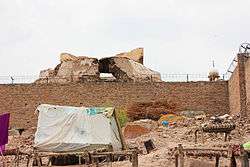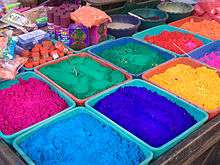Holi, Punjab


Holi in the Punjab region originated in the city of Multan[1] in the Prahlada-Puri Temple.[2] The original temple of Prahladpuri is said to have been built by Prahlada, son of Hiranyakashipu, the king of Multan (Kashya-papura)[3] in honor of Narasimha Avatar, an incarnation of Hindu god Vishnu, who emerged from the pillar to save Prahlada.[4][5][6][7] Holi also marks the advent of spring.[8][9]
Holi is celebrated over two days with Holika dahan being observed on Phagan Purnima or Pooranmashi (Full Moon), and Holi itself being celebrated the next day on the first day of Chet[10] according to the Punjabi calendar.
Etymology
The word "Holi" is derived from the word 'hola', which means to offer oblation or prayer to God as thanksgiving for good harvest.[11] The word 'holi' is also believed to be related to the Sanskrit word 'holka' which means 'half-baked corn'. Half-roasted gram and coarse wheat called hola were eaten on the day of Holi.[12] In the Punjab region, the wheat is harvested during the month of Vaisakh which arrives two months after Holi. Therefore, Holi is a thanksgiving festival for the future harvest.
Holi is also derived from the word Holika who was herself burnt to death when trying to burn her brother's son Prahlada in her laps.[11]
Prahlada-Puri Temple and Holika Dahan

_LACMA_M.82.42.8_(1_of_5).jpg)
Prahlada was a devotee of the Hindu God Vishnu. His devotion was tested by his furious father Hiranyakashipu who was the King of Multan.[8][13] As a result of his devotion he had been given special powers by Lord Vishnu. In his arrogance Hiranyakashipu made the people of Multan worship him instead of Lord Vishnu. But his son Prahlad Bhagat remained a devotee of the Lord.[8]
Hiranyakashipu poisoned Prahlada, had him trampled under the feet of mighty elephants and imprisoned him with snakes. Prahlada survived. Then he was forced to sit in the lap of Holika, in a great pyre.[2] Holika was the sister of Hiranyakashipu. She had a magical shawl which prevented her from being burned by fire. She offered to take Prahlada] in her lap and enter fire. This way Prahlada would be burnt, whereas Holika would remain protected by her shawl.
Legend has it that when she entered the fire, a strong wind blew and the protective shawl covered Prahlada instead of Holika. Holi in the Punjab begins with the symbolic burning of an effigy of Holika [8] a night before Holi and is known as Holika dahan.
While the fire was consuming Holika, Lord Vishnu appeared in the form of Narasimha (a half-man, half-lion avatar) and pounced upon Hiranyakashipu, cutting him into two pieces. The festival of Holi celebrates this incident, and the Sun-Temple of Multan is its memorial shrine [2] as the Temple marks the spot of the incident.
Holashtak

In the Punjab, Holi is celebrated as Holashtak over a nine-day period. Holashtak translates as Hola + Ashtak, which means eight days before Holi, that is Holashtak.[14] The festival ends on the day on Holi with colours and gulal. Holashtak announces the arrival of Holi. Also, from this day preparation of Holika dahan is started, further moving to Holi. [15]
For the Holika pujan, eight days before Holika Dahan, the area is cleaned with holy water. At that place two sticks are placed, one for Prahlada and the other for Holika. Dried cow dung cakes, dried wood and grass are placed by the two sticks.
From the day of Holashtak to the day of Holika dahan, everyday some small sticks or wood pieces are added. In this way, on the day of Holika dahan, the collection turns into a huge stack of wood which is burnt on Holika dahan. A small amount of colours of Holi are scattered.[16] The week-long observance of Holi was also observed by Maharaja Ranjit Singh and became part of the Lahore tradition of celebrating Holi.[17]
Holi
Matka or Ghara breaking
On the day of Holi, in the West Punjab[2] and East Punjab,[18] it is traditional to break a matki which is hung at a high spot. About six men will stand with their hands on each other's shoulders, bend forward and join heads and bring their right legs to form a pyramid, into the centre. Others will climb the pyramid to break the matka. The ones who are not participating throw water and colour on the pyramid. Traditionally, butter and milk are put in the matka, as this is supposed to re-enact the young Lord Krishna’s stealing of butter.[8]
Colours
People throw coloured powder on each other to celebrate Holi.
Chownk-purna
During festivals like Dussehra, Karva Chauth, Holi or Diwali in Punjab, mud walls and courtyards (where the art is drawn on cloth) of rural houses are enhanced with paintings to conjure blessings of Lakshmi, the goddess of wealth.
This art is known as chowk-poorana or chowkpurana in Punjab and is given shape by the peasant women of the state. Specific tree motifs, flowers, ferns, creepers, plants, peacocks, palanquins, geometric patterns along with vertical, horizontal and oblique lines result in a confluence of simplicity, intricacy and abstraction, lending credence to the importance of this artistry in the lives of the rural folk.[19]
Holi and Spring
Holi marks the end of the winter season[20] in the Punjab region where winter is divided into two seasons: Hemant for the Punjabi months of Maghar and Poh (November–January) and Shishir for the Punjabi months of Magh and Phagan (January–March). Holika dahan marks the end of the Shishir season and Holi marks the start of the Basant season.
Holi and Sikhism
The Sri Guru Granth Sahib Ji prescribes celebrating Holi by serving God. The colours of Holi manifest in the Lord's love. The celebration is described as follows:
"One Universal Creator God. By The Grace Of The True Guru: I serve the Guru, and humbly bow to Him. Today I am in supreme bliss. My anxiety is dispelled, and I have met the Lord of the Universe. Today, it is springtime in my household. I sing Your Glorious Praises, O Infinite Lord God. Today, I am celebrating the festival of Phalgun. Joining with God's companions, I have begun to play. I celebrate the festival of Holi by serving the Saints (Lord). I am imbued with the deep crimson colour of the Lord's Divine Love. My mind and body have blossomed forth, in utter, incomparable beauty. They do not dry out in either sunshine or shade; they flourish in all seasons. It is always springtime, when I meet with the Divine Guru. The wish-fulfilling Elysian Tree has sprouted and grown. It bears flowers and fruits, jewels of all sorts. I am satisfied and fulfilled, singing the Glorious Praises of the Lord. Servant Nanak meditates on the Lord, Har, Har, Har (God)." [21]
| Wikimedia Commons has media related to Festivals of Punjab. |
References
- ↑ A White Trail: A Journey into the heart of Pakistan's Religious Minorities by HAROON KHALID
- 1 2 3 4 Sohaib Arshad The Friday Times 31 12 2010
- ↑ Syad Muhammad Latif (1963). The early history of Multan. p. 3,54.
Kasyapa, is believed, according to the Sanscrit texts, to have founded Kashyapa-pura (otherwise known as Multan
- ↑ Gazetteer of the Multan District, 1923-24 Sir Edward Maclagan, Punjab (Pakistan). 1926. pp. 276–77.
- ↑ Imperial rule in Punjab: the conquest and administration of Multan, 1818-1881 by J. Royal Roseberry. pp. 243, 263.
- ↑ All the year round , Volume 51. Charles Dickens. 1883.
- ↑ Temple of Prahladpuri-Multan Survey & Studies for Conservation of Historical Monuments of Multan. Department of Archeology & Museums, Ministry of Culture, Government of Pakistan
- 1 2 3 4 5 Haroon Khalid The Friday Times 15 04 2011
- ↑ Temple of Prahladpuri Department of Archaeology & Museums Ministry of Culture, Government of Pakistan
- ↑ Fuller, Christopher John. (2004) The Camphor Flame: Popular Hinduism and Society in India. Princeton University Press
- 1 2 About Hinduism by Gyan Rajhans
- ↑ Bhavan's Journal, Volume 14, Issues 14-26 Bharatiya Vidya Bhavan 1968
- ↑ Legend of Ram–Retold By Sanujit Ghose
- ↑ The Tribune 25 February 2012
- ↑ Himachal News Kullu Celebrates Brij Ki Holi Dr Dev Kanya Thakur 8 January 2015
- ↑ http://www.astrobix.com/festivals_of_india/holi/holi_holaastak.aspx
- ↑ The Sunday Tribune Holi on Canvas Kanwarjit Singh Kang 13 March 2011
- ↑ http://festivals.iloveindia.com/holi/holi-celebrtions.html
- ↑ Drawing Designs on Walls, Trisha Bhattacharya (Oct 13, 2013), Deccan Herald; Accessed on 7 January 2015
- ↑ A Different Springtime Rite Wall Street Journal
- ↑ Sri Guru Granth Sahib Ji
